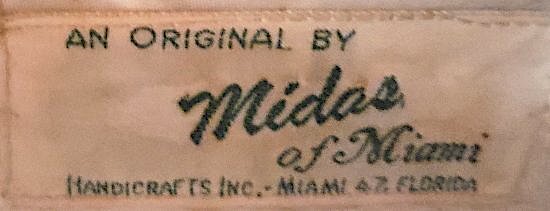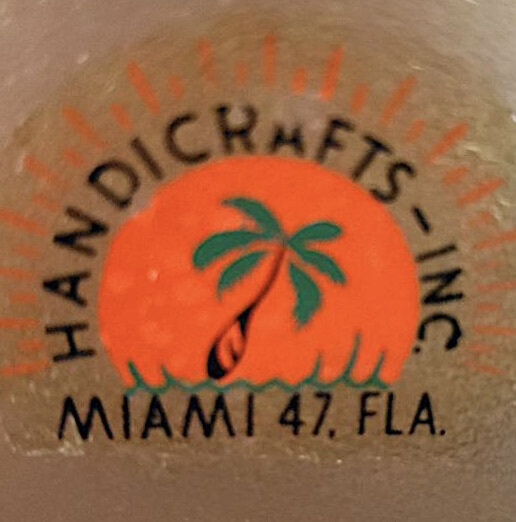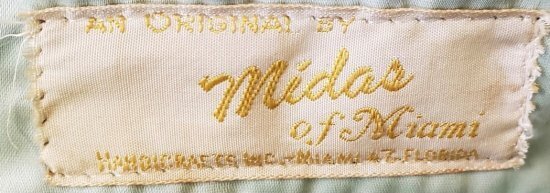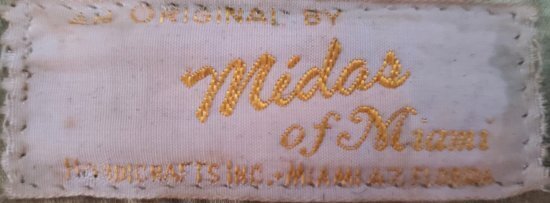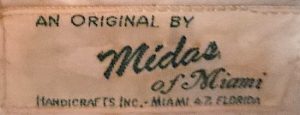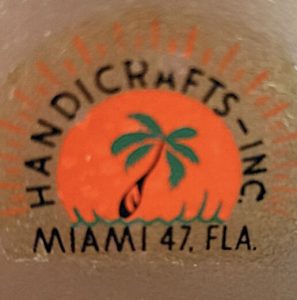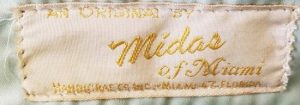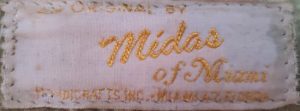Midas of Miami designer June Wagner Blum was born in Boston in 1913. Growing up, she learned from her tailor father, how to sew and create apparel. She met and married Daniel Wagner in 1933. Initially, they moved to Connecticut and opened a chain of liquor stores. However, due to June’s severe asthma, they moved to South Florida in 1949. After briefly working for Ann Taylor women’s clothes, June moved on to work with her husband Dan, as a designer and co-director of operations for their handbag manufacturing company, Handicrafts, Inc., which made Originals by Midas of Miami. Daniel Wagner was president of the company, located at NW 79th St., Miami. At first, June designed and hand-painted plates with palm trees using seashells, then decorated salt-and-pepper shakers and many other items. The biggest seller was honey jugs filled with orange blossom honey. The company moved to 9302 NW 22nd Ave, where they rented the building for the duration of the business. Their son Sanford “Sandy” Wagner worked for Midas of Miami for a time, helping Dan oversee shipping and general operations.
According to June and Dan’s sons, Kenneth and Sanford, June added beadwork to Lucite bags, but they did not sell well, so she discontinued making them. The straw handbags came from a traveling salesman, Irwin Baylin, who was living out of his car and appeared at the door. He asked June if she would look at some baskets. June looked at a basket and said she could paint it white, put some green paper in it, and place the honey jugs inside. Then, after some thought, she said, “I’ll bet I could make a lady’s handbag out of this. I’ll just paint it white, paint on the double lid ‘Sugar & Spice and Everything Nice’ and put inside a mirror and pockets.” This was the beginning of the straw handbag business. They later began importing basket bags from Hong Kong. The name Midas of Miami came from white bags that had gold flecks.
Known for its animal-shaped wicker purses, including the dog, monkey, elephant, fish and donkey, a common example of a Midas bag is a white-painted, picnic-style hamper, with their trademark gold-and-white braided handles, satin-lined interior, inner pocket and Midas of Miami label. Though basic, the bags became works of art with the addition of glued-on seed beads, velveteen flowers, fabric panels, and gold edging. More elaborate bags even had entire scenes. For example, there’s a Midas purse that displays its version of Aesop’s fable, “The Fox and the Grapes,” featuring a felt fox with rhinestone eyes, pining for the milk-glass, three-dimensional grapes fastened above him on the front of the purse, as well as on its top.
The bags had custom linings in a number of colors, and many included zipper pockets. The distinctive handles were designed by Dan and made by Fulford Manufacturing of Rhode Island. Fulford, which is still in business, also made the gold one-way buttons for Midas bags.
June designed all of the handbags, but also did custom orders. The company had seven employees who were allowed to decorate the bags only after proving they could execute each and every one.
The couple retired in 1975, closing Midas of Miami at that time, although Sanford continued to use the Handicrafts name for his asphalt business. Dan died in 1989. June married Irwin Blum in 1992, and lived in Bal Harbor until she died in 2016 at the age of 102. Known for her many charitable works, the city of Miami Beach honored her in 2001 with “June Blum Day” for her numerous contributions to Jewish causes and organizations.
Written by Vintagiality and Vintage Purse Museum
